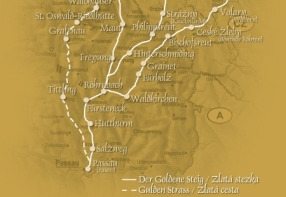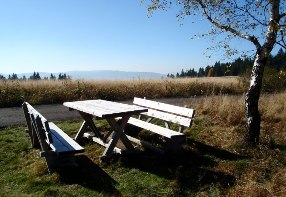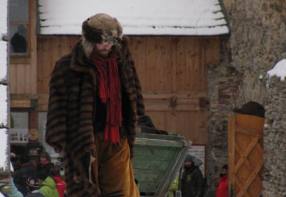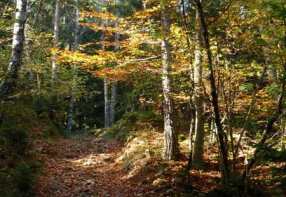Kašperské Hory branch of the Golden Path
The Golden Path undoubtedly belongs to the most important medieval trade routes in Central Europe. Its Designation "Golden" origins from the beginning of the 16th century and expresses the extraordinary value and yield of the trade being realized there. The main reason for building of this trading connection consisted in the deficit of salt in Czech lands. Salt was an essential part of life - used not only for cooking but also for foods conservation. The main sources of salt were salt mines in the Eastern Alps around Reichenhall and Hallein, from where salt was transported along the Inn River to Passau and afterwards by pack-horses across the Šumava to the border towns in Bohemia. Besides salt, the Path was also used for the import of precious fabrics, southern fruits, spices or wine to Bohemia, while grain, malt, honey, hops, wool or beer were transported in the opposite direction.
The first written records of the Golden Path date back to the beginning of the 11th century.
Three routes of the Golden Path developed gradually: the oldest one was the Prachatice branch or so-called Lower Golden Path, later it was the Vimperk branch (Middle Golden Path) and the latest one was the Kašperské Hory branch or Upper Golden Path.
The history of the latest part of the Golden Path has been written since 1356 when the Emperor Charles IV charged certain Heintzlin Bader from Červená with tracing and planning of this new commercial communication. In the same year also started construction of the guardian of this route branch - Kašperk Castle, which was completed and opened in 1361. Besides that, by the document from 5th January 1366, Charles IV dictates to all merchants using this path to spend their night in Kašperské Hory under the threat of a fine.
Selected sections of the Kašperské Hory branch in form of hollowed-out tracks have been distnictly preserved to date. They represent the most impressive and imposing footprints of this medieval trading communication in present. The route of the Kašperské Hory branch led mainly through the territory that was not permanently settled and that lacked fully developed human activity That is why it is possible to follow the route of the Golden Path in its almost original form - as was seen by pack-horses passing through the country hundreds of years ago.
In the summer season of 2011, new information boards will be installed at the Czech part of the Kašperské Hory branch of the Golden path.





